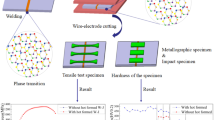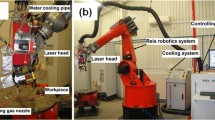Abstract
Ultra high strength steels are of enormous interest especially in the automotive industry due to their potential in realising light weight structures and improving the crash behaviour. However the poor formability of these steels limits their application for many parts in the car body. A solution to this limitation can be a local heat treatment using a laser beam to soften the material where a high formability is needed. Laser treatment was performed using a Nd:YAG laser with 3 kW maximum power. The output power was temperature controlled to achieve a constant temperature level during the heat treatment. Large areas are treated by scanning the surface with the laser beam. The materials under investigation are dual phase (DP), retained austenite (RA) and martensitic (MS) steels with a tensile strength of 600–1,200 MPa. The microstructure of DP steels consists of martensite and ferrite. RA steels contain ferrite, martensite and additionally a certain amount of retained austenite which transforms into martensite during plastic flow. MS steels are fully martensitic which gives them the highest yield strength of all UHS steels. The various steels were provided as not galvanised sheets (hot or cold rolled) with a thickness of 1.5 mm. Depending on material and process parameters tempering of martensite, formation of ferrite and transformation of retained austenite to martensite are observed as a result of the heat treatment. Tensile tests of DP 600, DP 1000 and MS-W 1200 reveal a significant reduction in yield and tensile strength and an increase in elongation after LHT. The effect is due to tempering of martensite and in the case of MS-W also due to an increase in volume fraction of ferrite. Tensile tests of RA-K 700 reveal a minor reduction in yield and tensile strength and a decrease in elongation. This can be attributed to the lower content of retained austenite which has transformed into martensite during LHT. From this result it can be expected that LHT is not beneficial for high deformation degrees. Deep drawing of a mock-up geometry using MS-W 1200 and RA-K 700 showed a significant decrease in slide force (~20%) compared to the initial condition. This results show that laser heat treatment has the potential to improve formability of UHS steels.









Similar content being viewed by others
References
n.n., (2002) Bessere Teilequalität beim Tiefziehen von Bauteilen aus hochfesten Stählen, Bleche, Rohre, Profile, Band 49(4): 36–39
Yamazaki K (2003) Current situation and properties of ultra-high strength steel for automotive use in Japan. Rev Met Paris 7–8:779–786
n.n., (1996) Sonderausgabe Werkstoffe im Automobilbau, Motortechnische Zeitschrift, Band 57:52–54
Kerausch M, Giera A, Geiger M (2003) Improved deep drawabilityof aluminium blanks by local laser heat treatment. In: Geiger M, Otto A (eds), Proceeding of 4th International Conference LANE, 2004, Erlangen, Germany, 21–24 Sept 2003, pp 1135–1146
Kerausch M, Giera A, Geiger M (2003) Improved material flow for deep drawing of aluminium blanks by local laser heat treatment. In: Kals HJJ, Shirvani B, Sing UP, Geiger M (eds), Proceedings of 10th International Conference on Sheet Metal, SheMet 2003, University of Ulster, Jordantown (Ireland), 14–16 April 2003, pp 73–80
Bergmann W (1997) Karosserieleichtbau mit höherfesten Stählen: Gewichtsreduzierung durch Umformen von höherfesten Stahlblechen mit partiell veränderten Kennwerten, Presentation at Leichtbau ‘97
Zajac J, Formability of Laser Annealed UHSS DP steels, SIMR-report, IM-2001-016
Weisheit A, Vitr G, Wissenbach K, Zajac J, Thoors H, Johansson B, Ribera E, Arino J, Sierra F (2005) Local heat treatment of ultra high strength steels to improve formability. In Vollertsen F, Seefeld T (eds), 1th International Workshop on Thermal Forming, IWOTE 05, Bremen, Germany, 14–16 April 2005, pp 63–81
Neugebauer R, Scheffler S, Poprawe R, Vitr G (2006) Verbesserung der Umformeigenschaften von schwer umformbaren Werkstoffen durch lokal vorinitialisierten Wärmeeintrag, EFB-Forschungsbericht Nr. 251, 2006
Author information
Authors and Affiliations
Corresponding author
Rights and permissions
About this article
Cite this article
Neugebauer, R., Scheffler, S., Poprawe, R. et al. Local laser heat treatment of ultra high strength steels to improve formability. Prod. Eng. Res. Devel. 3, 347 (2009). https://doi.org/10.1007/s11740-009-0186-9
Received:
Accepted:
Published:
DOI: https://doi.org/10.1007/s11740-009-0186-9




